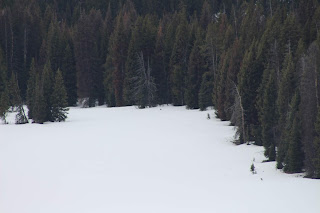Two days later, we decided to return to Towgetee Pass and the
park and look for more bears. Our first stop was up the pass and we didn’t see
any sign of the sow and cub grizzly we had seen on Thursday. Heading further up
the pass we stopped at an overlook and Renita spotted an animal running across
the snow field. Unfortunately, it was too far away to identify even after I took
several images with the three hundred mm telephoto lens.
Driving back down the pass, there was a bear jam right where
we had looked earlier. This bear jam was for a cinnamon black bear boar and we
watched it as it ran between trees.
A school bus unloaded by us, and teenagers
crowded in. Among the crowd we did see our son, his mother in law, and his
wife as they were also on a bear watching adventure.
The black bear disappeared into the trees and so we decided
to head to Pilgrim Creek, (it’s a prime spot to see a grizzly in Grand Teton National
Park. As we neared the first pull out the sight of a huge bear jam greeted us. Not
surprising as it was a holiday weekend, but it forced us to park half a mile
away from the bears.
Didn’t matter as we both needed the exercise and we soon
joined the crowd of photographers watching a sow grizzly and her two-year-old
cubs. We listened to the ranger as she told us it was bear 793 and her cubs. The
sow has been given the name Blondie by her fans, but the park service only
refers bears to their tag number.
The ranger also mentioned that bear 610, which had been
missing for a year had been reported and confirmed in a recent sighting. If
true it means that the sow had not been shot by a hunter as rumored by a local newspaper.
We watched as the bears grazed on the new grass. They
finally decided to cross the road and the sow had a talk with the cubs before
she returned to grazing.
The cubs choose to frolic in the snow, as they
wrestled in mock combat.
The mother bear finished eating and looking at the stopped
cars, the rangers blocked the traffic both ways, she crossed the road. This of
course raises the old question, “Why did the bear cross the road”?
After she
made it across both the cubs followed and they all disappeared into the trees.
It had been an entertaining hour and a half as we had
watched the bears. So, we next headed south to Willow Flats. Its another of our
favorite areas to spot a bear as it’s a place where cow elk congregate to
calve.
Returning up Towgotee Pass, we saw a fox that was busy hunting
mice in a patch of grass and sagebrush. We did not see any more bears, regardless
of that we were happy that we had seen four bears in one day, which is a great day
for us. Clear skies


































